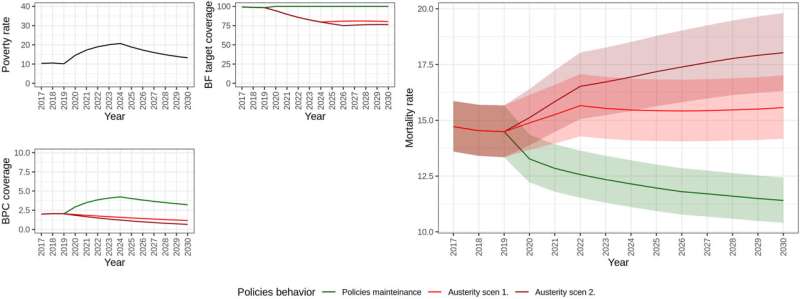This article has been reviewed according to Science X's editorial process and policies. Editors have highlighted the following attributes while ensuring the content's credibility:
fact-checked
trusted source
proofread
Social assistance programs found to be an effective strategy to mitigate the impact of economic crises on child health

Social assistance programs have strongly reduced child mortality in Brazil, and their expansion could prevent nearly 150,000 child deaths by 2030. The study, led by the Barcelona Institute of Global Health (ISGlobal), shows that social pensions and conditional cash transfers are an effective strategy to mitigate the impact of the current multiple global economic crises in low- and middle-income countries (LIMCs).
The COVID-19 pandemic, the war in Ukraine and the current inflation rate have led to an increase in the number of people living in extreme poverty which now stands at 700 million, half of whom are children. In addition, more than one billion children live in multidimensional poverty, with unmet basic needs in health, education and nutrition. With a global economic recession looming, poverty-related disease and death, especially among children, could increase substantially in LMICs unless effective strategies are rapidly implemented.
Brazil is one of the LMICs hardest hit by the current economic crisis. At the same time, the country has developed one of the largest social assistance strategies in recent decades, based on conditional cash transfers (CCT) for poor families (Programa Bolsa Família) and social pensions (SP) for the elderly and disabled (Benefício de Prestação Continuada).
"No study has ever estimated the joint impact of these two social assistance policies on child mortality or predicted the mitigating effects of both programs in times of economic crisis such as the one we are currently experiencing," explains Davide Rasella, ISGlobal researcher and coordinator of the study.
To do this, he and his colleagues at the University of Bahia in Brazil retrospectively analyzed the correlation between mortality rates for children under one year, one to four years and under five years for 2,548 municipalities across Brazil between 2004 and 2019, and the coverage of both programs in the same municipalities.
Both programs have saved many lives
The retrospective analysis shows that consolidated coverage of both programs (above 60% for CCT and above 66% for SP) significantly reduced child mortality rates (between 13 and 16% reductions). The poorer the community, the greater the impact on reducing child mortality, especially in the case of CCT, which are more focused on extreme poverty.
Cash transfers can contribute to reducing child mortality by enabling families to buy more and better food, as well as hygiene products or medicines. They also allow mothers to take a day off to take care of their sick child or take them to the hospital. They can also improve child health because they are linked to meeting certain health and education requirements.
Regardless of the mechanisms, Rasella's group has already shown the large impact of CCTs on child mortality in several Latin-American countries.
"The effect of social pensions, which are given to the elderly and disabled, was a bit more surprising and had not been described before," says Rasella. They could help reduce child mortality if the elderly live with their extended families and children, and also because some of the disabled are children.
And could save many more if expanded
The research team then used models to predict how many lives these programs could save in the coming years depending on whether their coverage remained the same (baseline), increased (mitigation), or decreased (fiscal austerity). The models show that expanding the coverage of both programs (mitigation strategy) could avert almost 150,000 child deaths by 2030, compared with the fiscal austerity scenario, which would lead to a considerable increase in child mortality.
"Our studies provide compelling evidence that reducing these programs due to fiscal austerity measures would be extremely harmful to child health," says Rasella. "On the contrary, they should be expanded to mitigate the impact of the current global crises on child mortality," he adds.
The paper is published in The Lancet Regional Health—Americas journal.
More information: Temidayo James Aransiola et al, The combined effect of social pensions and cash transfers on child mortality: evaluating the last two decades in Brazil and projecting their mitigating effect during the global economic crisis, The Lancet Regional Health—Americas (2023). DOI: 10.1016/j.lana.2023.100618



















